AMD Radeon HD 7870 GHz Edition & Radeon HD 7850 Review: Rounding Out Southern Islands
by Ryan Smith on March 5, 2012 12:01 AM ESTMeet The Radeon HD 7870 & Radeon HD 7850
For today’s review AMD sent over a 7870 and a 7850. Both are built on the 7870 reference design, so the cards are functionally identical except for the configuration of their respective GPU and the number of PCIe power sockets present.
For retail cards this will be very similar to the 7700 series launch, with partners doing semi-custom cards right away. In fact among the list of cards AMD sent us only Club3D will be using the complete 7870 reference design, while everyone else will be using the reference PCB along with their customary open air coolers. The 7850 will be even more divergent since AMD actually has a different, shorter reference PCB for these cards. Consequently our 7850 has very little in common with retail 7850s when it comes to their construction.
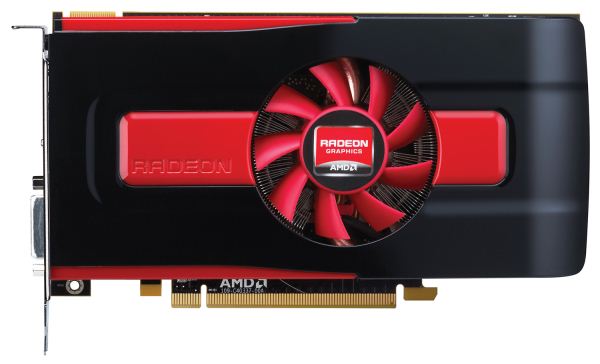
The Radeon HD 7850 Reference Design - Only Sampled To Partners
Starting as always with the cooler, the 7870 reference design is effectively a smaller version of the 7970 reference design. Here AMD is once again using a blower design with a slightly smaller blower, shrouded in the same hard red & black plastic as with the 7900. Underneath the shroud we find AMD’s heatsink, which utilizes a copper baseplate attached to 3 copper heatpipes, which in turn run into an aluminum heatsink that runs roughly half the length of the card. This is fairly typical for a blower design for a sub-200W card, but again almost all of the retail cards will be using a completely different open air design.
The 7870 PCB itself runs 9.5” long, with an additional .25” of shroud overhang bringing the total to 9.75”. Our card is equipped with 8 5GHz 256MB Hynix GDDR5 memory chips, the same 5GHz chips that we saw on the 7700 series. For the 7870 power is provided by a pair of 6pin PCIe power socket, while the sub-150W 7850 uses a single socket. Both cards feature a single CrossFire connector, allowing them to be paired up in a 2-way CrossFire configuration.
Meanwhile for display connectivity AMD is using the same configuration as we’ve seen on the 7900 series: 1 DL-DVI port, 1 HDMI port, and 2 miniDP ports. Interestingly, unlike the 7900 series and 7700 series there is a set of pads for a second DVI port on the card, and while AMD doesn’t make use of them at least one XFX card will. The 7800 series as the same display configuration options as the 7900 series though, so while it can drive up to 6 monitors it can only drive 2 TMDS type displays at once, and if you want to drive a full 6 monitors you’ll need a MST hub.
Finally, I wanted to touch on marketing for a bit. We typically don’t go into any detail on marketing, but with the 7800 something AMD did caught my eye. One of AMD’s marketing angles will be to pitch the 7800 series as an upgrade for the 5800 series; AMD doesn’t typically pitch cards as upgrades in this manner, and the 5800 comparison is especially odd.
At 2.5 years old the 5800 series is no longer the video card king but it’s also not particularly outdated; other than tessellation performance it has held up well relative to newer cards. More specifically, the 7800 series performance is roughly equal to the 6900 series, and while the 6900 series as a step up from the 5800 series it was not a massive leap. With its $350/$250 MSRP the 7800 series has common pricing with the 5800 series, but at only 20-40% faster than the 5800 it’s not the kind of step up in performance that typically justifies such a large purchase. Of course AMD’s conservative pricing has a lot to do with this, but at the end of the day it’s odd to call the 7800 series the upgrade for the 5800 series when the 7950 is the more natural upgrade from a performance perspective.


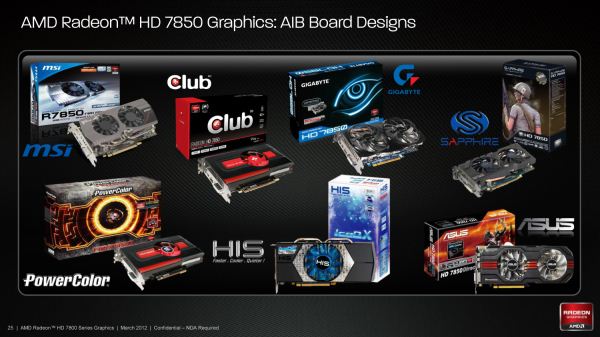
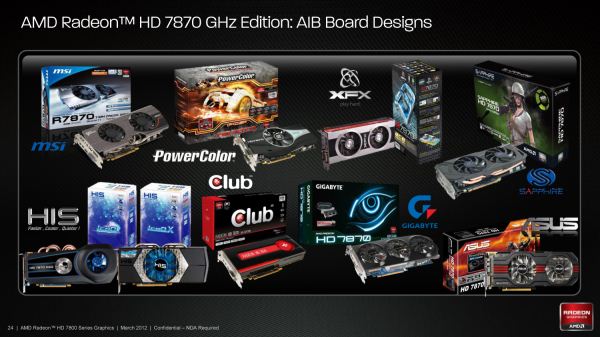

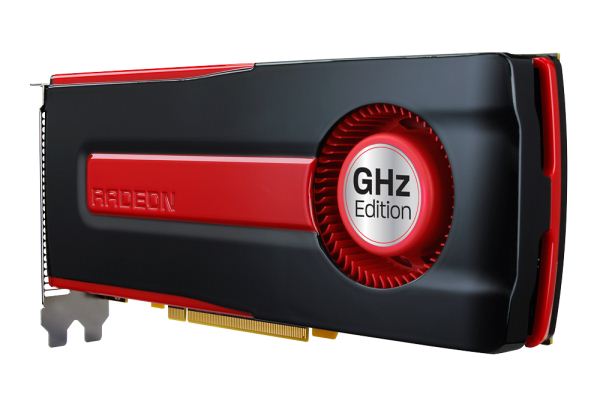












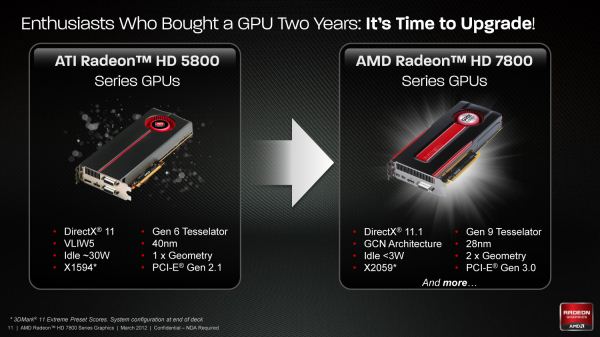








173 Comments
View All Comments
ET - Monday, March 5, 2012 - link
I agree it's kind of disappointing. Even a 5750 was a good improvement over a 3870, and here there's nothing approaching this kind of performance benefit over the 5870 from these. Though I think part of it is that the 5870 still holds up well in many games, as these benchmarks show.Kjella - Monday, March 5, 2012 - link
I don't think it's that terrible... the 7870 fits pretty much the exact same power envelope as the 5850 and is starting to be a pretty solid performance upgrade. Yes it's a $350 card but inflation adjusted the $279 (pre-hike) 5850 is nearing $300 in 2012 dollars. A good deal and a good cooler (the reference cooler on the 5850 works, but is hardly quiet) and they may get a sale. Just waiting for Ivy Bridge, if nVidia hasn't shown a stunning Kepler by then I think the 7870 is it.Death666Angel - Tuesday, March 6, 2012 - link
Average increase of 40% in performance and you are comparing a high-end graphics card to a mid-range graphics card.DominionSeraph - Monday, March 5, 2012 - link
So, AMD discontinued the $250 6950 and $350 6970 to give us... a $250 6950 and $350 6970.Not exactly impressed.
Looks like it will be up to Nvidia to save us, just as they saved us from the price-gouged 5000 series with aggressive release price of the GTX 460 with price drops on the GTX 470. (That one action set the pricing scheme throughout the 6000/500 series)
CloudFire - Monday, March 5, 2012 - link
I'm not upgrading this cycle but I do wish to see Kepler out sooner to drive down prices. This is business and AMD has a few months of no competition so they are going to do all they can to reap massive profits.Nvidia isn't going to save you, they would do the same thing if they were in AMD's position. Remember nearly 5 years back with the 8800GTX going for 500+ for over a year? Yea......
DominionSeraph - Tuesday, March 6, 2012 - link
A halo product with no competition is beside the point. We're talking about the 7800 series which sits right in a range where there are competing products, and AMD is pricing it to suck you dry.The fact is that the 7000 series is not undercutting the 500 series the way Nvidia undercut the 5000 series. A $250 7850 vs a $270 + free Batman Arkham City GTX 560 Ti 448 Cores is about equal price/performance (maybe a tad in the favor of Nvidia). Contrast this to the GTX 460 being released at $200 when the 5770 was $180. The GTX 460 blew the doors off the 5770 and instantly said the appropriate price for that card is ~$130. A few months later we were seeing $110 5770's and $150 GTX 460's, and that's where we've been at ever since.
AMD refuses to aggressively compete with Nvidia. They simply slot their products into Nvidia's pricing structure. So prices only change when Nvidia drops theirs and AMD is forced to follow. This means that we, the consumers, are dependent on Nvidia to save us, because AMD sure as hell won't.
Exodite - Tuesday, March 6, 2012 - link
Not really a valid point of comparison though.Looking through several reviews of the 7800-series the 7850 lies closer to a 570 than a 560 Ti most of the time, while offering more and better in every possible category.
Sure, the 7850 isn't on the market yet but assuming the ~250 USD pricing holds true I couldn't possibly recommend a 560 Ti, or even 448 core version, over the 7850 with a straight face.
It could still be cheaper, sure, but it's nowhere near the pricing disaster the 7900 and 7700 series are.
To my mind the 7800 series were the ones to wait for.
Granted, with a 6950 myself I won't be upgrading until the 8k-series at the earliest. Unless Kepler turns out truly amazing, and brings triple display functionality on a single card.
tipoo - Monday, March 5, 2012 - link
If I recall Nvidia hasn't really under-priced AMD in recent memory, they've always tried x more performance sold for >x price.ET - Monday, March 5, 2012 - link
"AMD discontinued the $250 6950 and $350 6970 to give us... a $250 6950 and $350 6970."When you put it this way, it's quite a likeable upgrade actually. Slight boost in performance, lower power and better thermals, upgraded features, all for the same price. What's not to like?
chizow - Monday, March 5, 2012 - link
What's not to like is it took them 16 months to put out a greener refresh sidegrade.